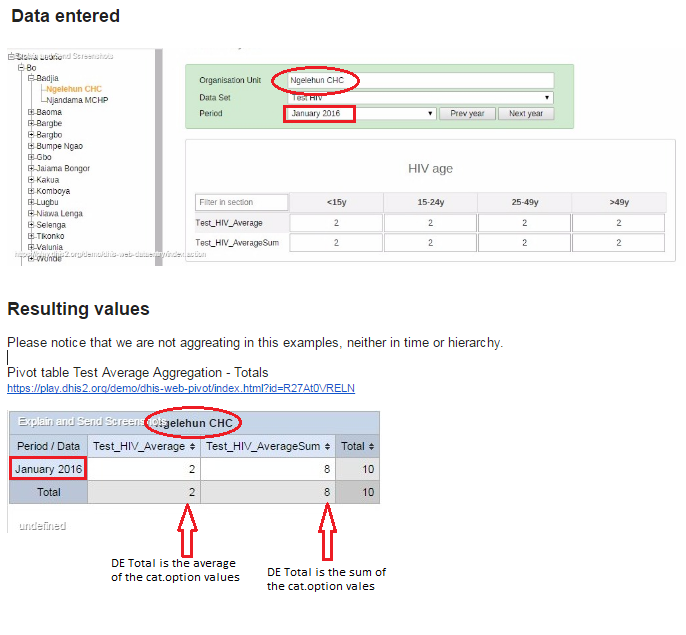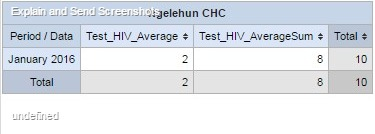dhis2-devs team mailing list archive
-
 dhis2-devs team
dhis2-devs team
-
Mailing list archive
-
Message #48471
Re: DE Average aggregation type returns average of category options as Total
Hi Lars,
thank you for your answer. I understand that you describe the use of
Average (sum in hierarchy). We actually use it for population, beds in the
hospital.... Also I like the name and the agg. operator ;)
However, what I was pointing out was the behaviour of the aggregation type
"Average", in contrast with "Average (sum in org.unit)" *without any
aggregation neither in time or in the hierarchy*.
They behave differently and I was wondering if it is done on purpose. Maybe
my introduction was misleading.
Let me copy it again.
[image: Inline images 1]
I do have a use case in which I need average in time, average in hierarchy,
and still keep the value of the Data Element as the sum of the values
entered in the category options.
Cheers,
Marta
On 27 January 2017 at 10:35, Lars Helge Øverland <lars@xxxxxxxxx> wrote:
> Hey Marta,
>
> thanks for bringing this up.
>
> I guess the naming of the aggregation operator "Average (Sum in
> hierarchy)" is currently a bit misleading. It should perhaps have been "Sum
> (Average in time)", as we currently sum across the category dimensions.
>
> So yes, it can be argued that the current behavior is wrong. However I am
> not sure if we should change it (perhaps instead alter the name of the
> operator). A typical use-case for this aggregation operator is population
> or staff data. Think about a case where HR data is collected quarterly at a
> facility:
>
> *Quarter 1*
> Doctors: 10
> Nurses: 10
>
> *Quarter 2*
> Doctors: 10
> Nurses: 10
>
> *Quarter 3*
> Doctors: 20
> Nurses: 20
>
> *Quarter 4*
> Doctors: 20
> Nurses: 20
>
> Here HR/staff is a data element, and the types of staff are category
> options.
>
> In this case, when aggregating for the year and for an entire country, you
> could like the aggregated value for the HR data element to be 30, by
> summing up the org units and category options, but averaging across the
> quarters.
>
> Do you have a specific requirement for the behavior where you need to sum
> in the org unit hierarchy and average across all other dimensions, or is it
> more to point out unexpected behavior/possible bug? I am willing to rename
> the aggregation operator to make it clearer.
>
> Would be interesting to get others input on this as well.
>
> best,
>
> Lars
>
>
>
>
>
>
> On Wed, Jan 11, 2017 at 11:48 AM, Marta Vila <martavila@xxxxxxxxx> wrote:
>
>> Hi all,
>>
>> we have observed that when we set aggregation type in a DE collected with
>> category options, when we ask for the total value we obtain the average of
>> the values introduced in each category instead of the sum.
>>
>> Please see the example bellow. It is configured and tested in the demo
>> server now. It will disappear tomorrow... I'm sending also screenshots.
>>
>> We would like to know if this is the intended behaviour before reporting
>> it in Jira.
>>
>> Cheers,
>>
>> Marta
>>
>> *Configuration of DE: *
>>
>> *Test_HIV_Average* has aggregation type Average
>> *Test_HIV_AverageSum* has aggregation type Average (sum in hierarchy)
>>
>>
>> *Data entered*
>>
>> [image: Inline images 2]
>>
>>
>> *Resulting values*
>>
>> Please notice that we are not aggreating in this examples, neither in
>> time or hierarchy.
>>
>> Pivot table Test Average Aggregation - Totals
>> https://play.dhis2.org/demo/dhis-web-pivot/index.html?id=R27At0VRELN
>>
>> [image: Inline images 1]
>> Pivot Table Test Average Aggregation - Details
>> https://play.dhis2.org/demo/dhis-web-pivot/index.html?id=XIkxuP2unBJ
>>
>> [image: Inline images 2]
>>
>> _______________________________________________
>> Mailing list: https://launchpad.net/~dhis2-devs
>> Post to : dhis2-devs@xxxxxxxxxxxxxxxxxxx
>> Unsubscribe : https://launchpad.net/~dhis2-devs
>> More help : https://help.launchpad.net/ListHelp
>>
>>
>
>
> --
> Lars Helge Øverland
> Lead developer, DHIS 2
> University of Oslo
> Skype: larshelgeoverland
> lars@xxxxxxxxx
> http://www.dhis2.org <https://www.dhis2.org/>
>
>




References